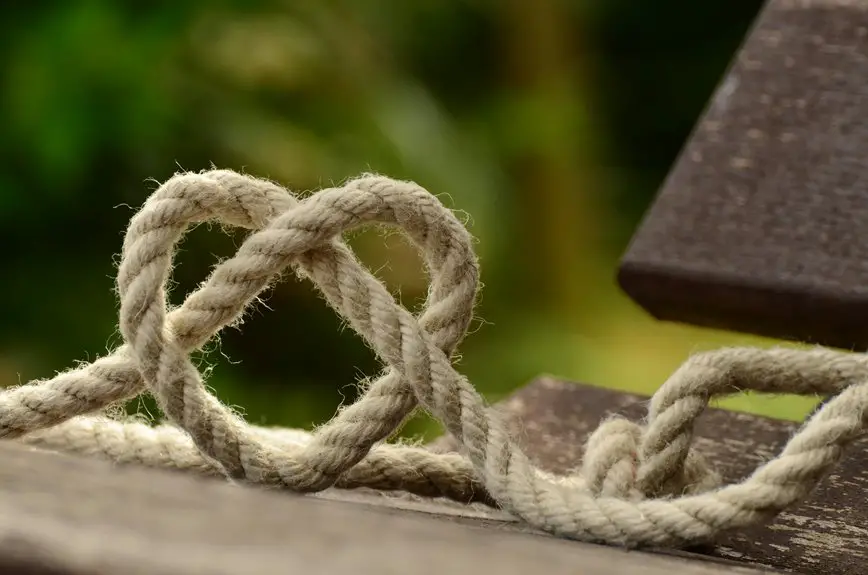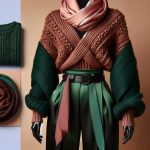You’ll find jute fabric has a coarse, rustic texture with a matte finish that adds natural warmth to any item. It’s impressively strong and durable, resisting wear while staying breathable and moisture-wicking, keeping you comfortable. Plus, it’s eco-friendly, being biodegradable and requiring minimal chemicals to grow. Jute’s versatility makes it great for bags, rugs, and home décor. Keep exploring to uncover its maintenance tips and how it compares to other natural fibers.
Table of Contents
Key Takeaways
- Jute fabric features a coarse, fibrous texture with a rustic, matte finish ranging from golden brown to beige tones.
- It offers strong tensile strength and durability, suitable for heavy-duty textile applications like bags and rugs.
- The fabric is breathable and moisture-absorbent, allowing air circulation and wicking away sweat for comfort.
- Jute is environmentally sustainable, biodegradable, grows quickly with minimal chemicals, and supports eco-friendly farming.
- Cleaning requires gentle care with mild detergents, avoiding harsh chemicals and direct sunlight to maintain fabric integrity.
Natural Texture and Appearance of Jute
Jute’s natural texture stands out with its coarse, fibrous feel that you can easily notice at a touch. When you run your fingers over it, you’ll sense a rough surface, unlike smoother fabrics like cotton or silk.
Its appearance reflects its earthy origins, showcasing a matte finish with subtle variations in color ranging from golden brown to beige. These color shifts give jute a rustic, organic look that adds warmth and character to any item made from it.
You’ll also notice tiny, uneven strands woven tightly, creating a distinctive pattern that highlights its handmade appeal. This natural texture and appearance make jute ideal for eco-friendly products, offering both aesthetic charm and a tactile experience you won’t find in synthetic fabrics.
Strength and Durability Features
You’ll appreciate how jute’s tensile strength holds up under pressure, making it a reliable choice for many uses.
Its resistance to wear means it stays intact even with frequent handling.
Plus, jute’s durability guarantees it lasts long, maintaining performance over time.
Tensile Strength Properties
Although natural fibers often vary in strength, jute fabric stands out for its impressive tensile strength, making it a reliable choice when durability matters.
When you use jute, you benefit from fibers that resist breaking under tension, which is essential for applications like bags, ropes, and rugs. Its tensile strength allows the fabric to hold heavy loads without tearing easily.
You’ll find that jute’s strength comes from its long, strong cellulose fibers, which provide both rigidity and flexibility. This means jute fabric maintains integrity even when stretched or pulled.
Resistance to Wear
Wear resistance plays an essential role when selecting fabric for everyday use, and jute excels in this area.
You’ll find that jute’s coarse fibers naturally withstand friction and abrasion better than many other natural fabrics. This means it holds up well when used in items like bags, rugs, or upholstery that encounter regular rubbing.
Although not as smooth as cotton or silk, jute’s texture contributes to its ability to resist wear without quickly thinning or tearing. When you use jute fabric, you can expect it to maintain its integrity despite frequent handling or rough conditions.
Just keep in mind that while jute resists surface wear effectively, it still requires proper care to avoid damage from moisture or prolonged exposure to sunlight.
Longevity Under Stress
Durability defines jute fabric’s ability to endure stress over time without losing its strength. When you use jute, you’ll notice it handles tension and pressure remarkably well, making it ideal for heavy-duty applications like sacks and upholstery.
Its natural fiber structure provides excellent tensile strength, so it won’t tear or fray easily under regular use. Even when exposed to repeated bending or stretching, jute maintains its integrity longer than many other natural fabrics.
However, to maximize longevity, you should keep it dry and avoid prolonged exposure to harsh elements, as moisture can weaken the fibers. By understanding and respecting these limits, you can rely on jute fabric for lasting performance in demanding environments.
Breathability and Moisture Absorption
You’ll appreciate how jute’s natural airflow keeps air moving through the fabric, helping you stay cool.
It also has a strong moisture-wicking ability that pulls sweat away from your skin. This makes jute comfortable to wear, especially in humid conditions.
Natural Airflow Properties
Although jute fabric is primarily known for its strength, it also excels in natural airflow properties that enhance breathability and moisture absorption.
When you use jute, you’ll notice its loosely woven fibers allow air to circulate freely, keeping the material cool and comfortable against your skin. This natural ventilation helps prevent overheating, making jute ideal for warm climates or prolonged wear.
Additionally, jute’s fibrous structure readily absorbs moisture from the environment without feeling damp, so it maintains a dry touch. You’ll find that this combination of airflow and moisture absorption supports comfort without relying on chemical treatments.
Moisture Wicking Ability
Moisture wicking is a key feature that makes jute fabric highly breathable and comfortable. When you wear or use jute, you’ll notice it quickly pulls moisture away from your skin, keeping you dry.
This happens because the fibers naturally absorb water and then release it through evaporation. Unlike synthetic fabrics, jute doesn’t trap sweat or humidity, so you stay fresher for longer.
Its coarse texture and porous structure help in efficiently channeling moisture outward. By managing moisture effectively, jute prevents the damp, clammy feeling that often comes with other materials.
Comfort in Humid Conditions
When humidity rises, jute fabric excels at keeping you comfortable by allowing air to flow freely and drawing moisture away from your skin.
Its natural fibers create a breathable structure that promotes ventilation, preventing heat buildup and reducing sweat accumulation. You won’t feel sticky or weighed down because jute absorbs moisture efficiently, helping to keep your body dry even in muggy conditions.
Unlike synthetic fabrics that trap heat, jute’s moisture-wicking ability guarantees you stay cool and fresh.
Whether you’re wearing jute clothing or using jute-based home textiles, you’ll notice how well it manages dampness and airflow. This makes jute a smart choice if you often find yourself in warm, humid environments and want to stay comfortable without sacrificing style.
Environmental Sustainability and Biodegradability
Because jute fabric is made from natural plant fibers, it offers impressive environmental sustainability that you can feel good about. You’re choosing a material that requires minimal pesticides and fertilizers, reducing harmful chemical runoff.
Jute plants also absorb large amounts of CO2, helping combat climate change. When you use jute, you support a crop that grows quickly and replenishes the soil, promoting sustainable farming practices.
Additionally, jute is fully biodegradable. When you dispose of jute fabric, it breaks down naturally without leaving toxic residues, unlike synthetic fibers.
This means you’re reducing landfill waste and pollution. By opting for jute, you actively contribute to a healthier planet with a fabric that’s renewable, eco-friendly, and designed to return harmlessly to the earth.
Versatility in Textile Applications
Jute fabric adapts easily to a wide range of textile applications, making it a practical choice for many uses.
You’ll find it in everything from bags and rugs to upholstery and curtains. Its natural strength and coarse texture provide durability, so it holds up well under frequent use.
Plus, jute blends nicely with other fibers, allowing you to customize the fabric’s feel and appearance for different projects.
Whether you’re creating rustic home décor or sturdy packaging materials, jute offers versatility without sacrificing eco-friendliness.
Its breathable quality also makes it suitable for items like wall hangings or storage sacks, where ventilation matters.
Care and Maintenance Tips for Jute Fabric
Although it’s a durable fabric, you’ll want to handle jute with care to keep it looking its best.
Jute is sturdy but requires gentle care to maintain its natural beauty and longevity.
Avoid exposing it to excessive moisture since jute absorbs water easily, which can weaken the fibers and cause mold.
When cleaning, use a soft brush or vacuum to remove dust gently. Spot clean stains with a mild detergent and cold water, but don’t soak the fabric.
Always air dry jute items away from direct sunlight to prevent fading and brittleness. Store jute products in a cool, dry place to avoid mildew.
Avoid harsh chemicals or bleach, as they can damage the natural fibers.
Comparison With Other Natural Fibers
When you compare natural fibers, you’ll notice each has unique qualities that suit different uses and preferences.
Jute stands out for its coarse texture and strong, durable nature, making it ideal for bags, rugs, and upholstery. Unlike cotton, which is softer and more breathable, jute isn’t typically used for clothing.
Linen offers a smoother finish and better moisture-wicking, but it’s less affordable than jute. Hemp, similar in strength, is more resistant to pests and mold but feels rougher.
If you want an eco-friendly, sturdy fiber with a rustic look, jute’s a great choice. While it may lack the softness of other fibers, its affordability and biodegradability make it an excellent option for sustainable products and home décor.
Frequently Asked Questions
Can Jute Fabric Be Dyed in Vibrant Colors?
You might think jute can’t hold vibrant colors, but it surprisingly can. You’ll need proper mordants and techniques to make those hues pop, transforming its natural rustic look into something striking and colorful.
What Is the Historical Origin of Jute Cultivation?
You’ll find jute cultivation began in the Indian subcontinent, especially Bengal, over centuries. Farmers have passed down techniques, making it essential for local economies and traditional crafts, shaping its rich agricultural history.
Are There Any Health Risks Associated With Jute Fabric?
Imagine wearing rough fabric that irritates your skin all day—that’s a potential risk with jute. While generally safe, its coarse fibers can cause itchiness or allergies, so you should test it on your skin before prolonged use.
How Does Jute Fabric Perform in Extreme Weather Conditions?
You’ll find jute fabric struggles in extreme weather; it absorbs moisture easily, which can weaken fibers and cause mildew. However, in dry conditions, it holds up well but isn’t ideal for prolonged wet or freezing environments.
Is Jute Fabric Suitable for Upholstery Purposes?
You’ll find jute fabric is 100% biodegradable and eco-friendly, making it great for upholstery in low-traffic areas. However, it’s less durable than synthetic fabrics, so it won’t hold up well under heavy everyday use.
- The Use of Nonwovens in Construction and Civil Engineering - July 11, 2025
- The Use of Nonwovens in Construction and Civil Engineering - July 11, 2025
- The Use of Nonwovens in Construction and Civil Engineering - July 11, 2025







